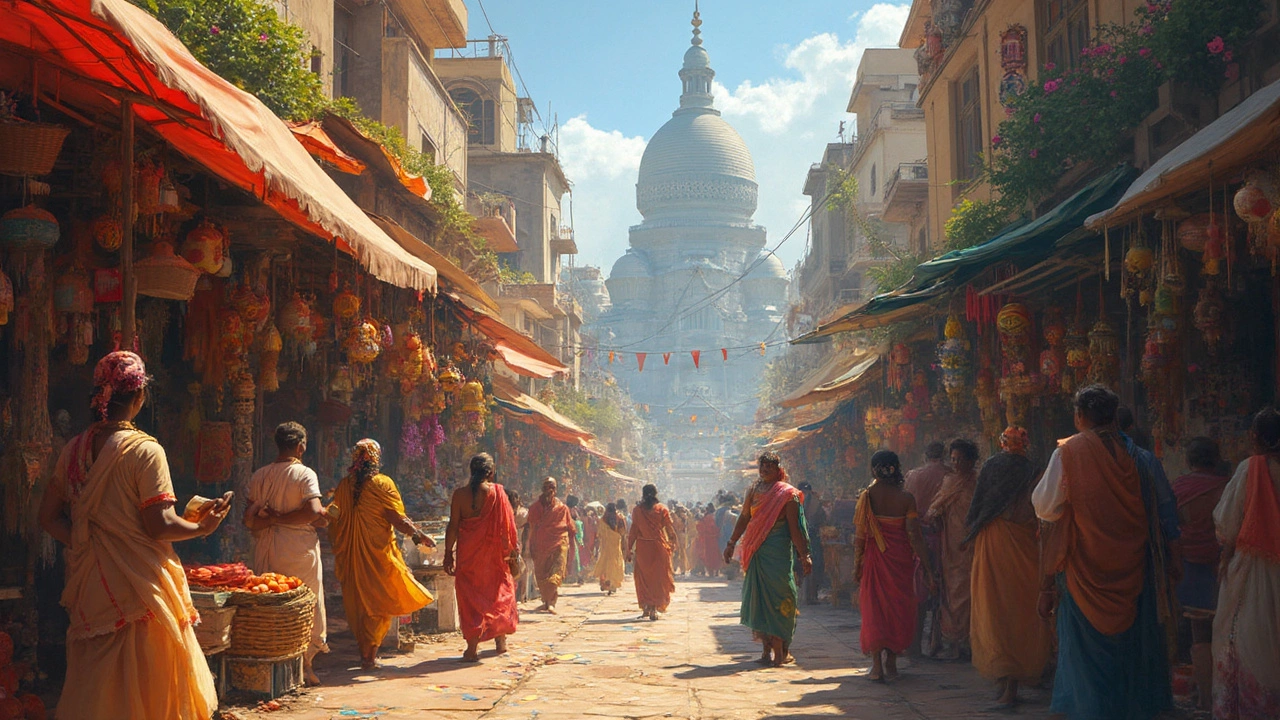Is the USA Wealthier Than India?
 Mar, 28 2025
Mar, 28 2025
When people think about wealth, the first thought often is money. Sure, it's a big piece of the puzzle, but is it the whole picture? The USA, with its whopping GDP of trillions, clearly outshines India in economic terms. Does that mean it's richer in every sense?
Not really. India offers a kind of wealth that's not measured in dollars or tallied on a spreadsheet. With its vast history and spiritual depth, India shows that richness can mean more than cash flow. It draws attention to cultural and spiritual riches that have no price tag.
- Economic Measurements
- Cultural and Spiritual Wealth
- Wealth Distribution
- Lessons from Spiritual Quotes
Economic Measurements
So, we're talking about economic measurements. The USA is like this giant when it comes to economics. We're talking about a GDP of about $25 trillion as of 2023. It's the world's largest economy by a size that can make your head spin. The USA's economy is built on industries like technology, healthcare, and finance, driving its global influence.
In contrast, India's GDP is around $3.5 trillion, a stark difference. But hold on a minute! India's growth rate is something the world takes seriously, consistently hitting around 7% annually, which is pretty impressive. Its economy thrives on sectors like information tech, agriculture, and textiles.
Let's not forget purchasing power. The purchasing power parity (PPP) tells another story. The PPP might suggest a smaller gap when comparing USA wealth and India's. It adjusts for cost of living differences, making the comparison not as unequal.
Here's where things get even more interesting. The USA is a consumer-driven economy—people buying things keep it ticking. Meanwhile, India, with a younger population, is poised to be a future powerhouse. Demographics play a huge part in these economic dynamics.
Of course, it's not just about size and growth. The wealth distribution part of the story is crucial too. But we'll get into that in another section. For now, it's clear the headlines might say the USA is 'richer', but there's a lot more under the surface when it comes to economic comparisons.
Cultural and Spiritual Wealth
When you think about what makes a nation truly rich, it's not just the numbers on a ledger. India's spiritual and cultural wealth offers a different view. Consider the concept of 'Atithi Devo Bhava', which means 'The guest is God.' This shows the deep values of hospitality and respect, woven into everyday life.
India has a legacy of spiritual leaders and philosophers like Mahatma Gandhi and Swami Vivekananda, who have spread messages of peace and love that resonate globally. The teachings of the Bhagavad Gita alone have inspired people worldwide to reflect on life's deeper meanings beyond material success.
On the other hand, the USA brings its own cultural richness through diversity. It's a melting pot where ideas and traditions from all over the world mix. This blend gives rise to innovations in art, music, and technology that influence the rest of the globe.
Both countries offer lessons in spiritual wealth, teaching us that true prosperity often lies in the power of ideas, the strength of community, and the depth of human connection.

Wealth Distribution
So, when it comes to spreading the wealth around, how do the USA and India compare? Well, this is where things get interesting. In the USA, a lot of the wealth is concentrated in the hands of a few. You've probably heard the statistic: the top 1% own a significant chunk of the country's total assets. This pattern often raises eyebrows about inequality.
India faces its challenges too. While the country has made strides in reducing poverty, a big gap remains between the rich and poor. The contrast is visible in its metropolitan cities where luxury malls can stand next to informal settlements. The concentration of wealth remains with industrialists and a growing tech-savvy middle class.
Here's a quick look that might surprise you:
| Country | Gini Index (Wealth Inequality Index) |
|---|---|
| USA | 41.5 |
| India | 35.7 |
The Gini Index is a tool for measuring inequality, so while both nations have disparities, it’s interesting to see India having a slightly lower score – hinting at diverse wealth divisions.
Both countries face debates about the best ways to address wealth inequality. What's common in many discussions is the role of policy-making and social programs in creating a more balanced society. At the end of the day, making wealth distribution fairer isn’t just about taxes or salaries; it's about providing opportunities and reducing barriers for everyone.
Lessons from Spiritual Quotes
Diving into spiritual quotes offers tons of insight into what it truly means to be wealthy. India's spiritual leaders and texts teach that wealth isn't just about stacking up money or possessions. It's about the richness of experience, peace of mind, and connection to others.
Take, for instance, the wisdom of Mahatma Gandhi, who said, "Live as if you were to die tomorrow. Learn as if you were to live forever." This reminds us that true wealth includes continuous self-growth and valuing our time. It asks us to focus as much on personal development as on financial success.
In contrast, many look to American thinkers like Ralph Waldo Emerson, who said, "To be yourself in a world that is constantly trying to make you something else is the greatest accomplishment." This perspective highlights individuality and personal strength as forms of wealth.
Let's not forget about how these teachings emphasize balance. Harmony between your inner and outer worlds can be the most enriching experience, surpassing material gains.
For those who want to merge material success with spiritual growth, spiritual quotes from both the USA and India offer practical advice. They nudge us to appreciate the present moment, stress less about the uncontrollable, and invest in relationships just as much as in bank accounts.